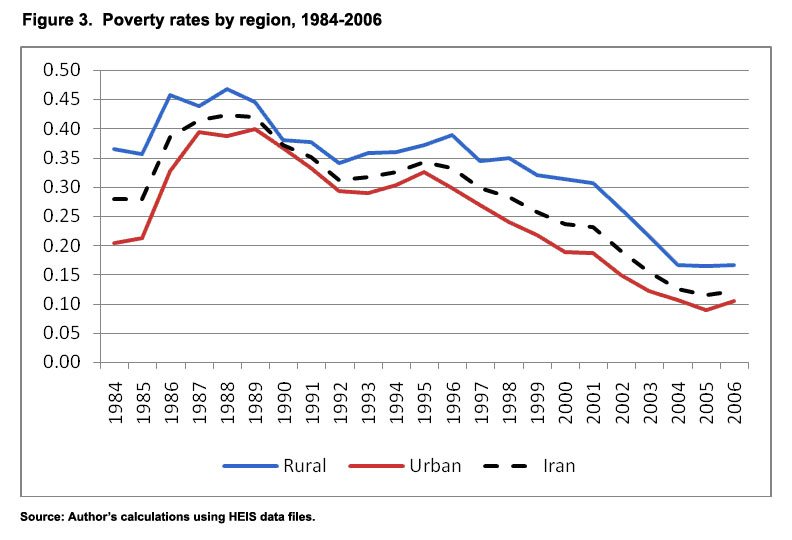Iran has suffered from extreme levels of poverty for over forty years. In December 2017, protests took place across the country protesting four decades of a brutal dictatorship that was responsible for the deteriorating Iranian economy, corruption, and suffering to Iranian people. Supreme Leader Khamenei and President Rohani neglected the people’s misery throughout their rule, but Rohani promised that before the end of his second term in 2021, he would abolish absolute poverty in Iran. Despite these claims, he has done nothing to improve living conditions and poverty for the people of Iran. In 2017 it was estimated that roughly 14% of the population was living below the poverty line. However, due to the government not releasing information regarding poverty in the country, it is difficult to assess the accuracy of this estimation.

The current ruling regime has made it difficult to obtain accurate numbers regarding poverty in the country over the last forty years due to the strict academic censorship. The supreme leader Ali Khamenei controls the Iranian economy and is therefore responsible for poverty in Iran. Despite the constant claims that Iranian officials will improve poverty in the country, the supreme leader did not take the first step in reducing poverty until 2004. In 2004, the government put into action the Comprehensive Structure of Social Welfare and Security Law. This Law required for there to be absolute and relative poverty lines and the poverty in the country has to be measured of a regular basis. While the laws enacted by the Iranian government did not actually do anything on their own to improve poverty in the country, it is a major step because prior to the enactment of this law, Iran had no adequate official assessment of the poverty line.

Living on less than $5.50 a day constitutes poverty in Iran. The poverty rate in Iran increased annually from 2014 to 2016 but then had a .7% decrease in 2017 from 2016. However, as of 2017, the poverty rate in Iran was still higher than it was in 2014. Overall, the poverty rate in Iran has decreased dramatically; however, the poverty rate has not remained on a constant decrease. This indicates that the supreme leader is not actively trying to abolish absolute poverty in Iran. The cost of living in Iran has been rising causing millions more people to fall under the poverty line. The amount of people living under the poverty line in Iran has been increasing because most workers and laborers in Iran do not earn enough to reach the poverty-line income they need to subsist. The economic downturn in Iran due to inflation, decreased oil prices, and economic sanctions imposed on Iran by the United States has led to an increase in poverty rates.
Philip Alston, the former UN Special Rapporteur on extreme poverty and human rights, condemns the failed global poverty eradication efforts. He claims that although overall the global economy has improved, individual economies across the world have not improved leading to extreme wealth inequalities. Wealth inequality in Iran is also partially responsible for the high poverty rates. There are very wealthy individuals in Iran, but the majority of the population lives below or slightly above the poverty line. Even families that live above the poverty line struggle to survive because the poverty line is defined as living on $5.50 a day. For a family to live comfortably they need much more than what constitutes poverty.
In Iran it is difficult to gauge accurate statistics for the percent of the population living below the poverty line because the government is reluctant to publicly present information regarding the poverty line because in doing so, government officials would reveal their failure to improve poverty.
Bibliography
Alston, P. (2020, July 5). Philip Alston Condemns Failed Global Poverty Eradication Efforts – NYU School of Law. Retrieved October 08, 2020, from https://chrgj.org/2020/07/05/philip-alston-condemns-failed-global-poverty-eradication-efforts/
Human Rights Council. (2020). The parlous state of poverty eradication. Retrieved October 08, 2020, from https://chrgj.org/wp-content/uploads/2020/07/Alston-Poverty-Report-FINAL.pdf
Iran Poverty Rate 1986-2020. (n.d.). Retrieved October 09, 2020, from https://www.macrotrends.net/countries/IRN/iran/poverty-rate
Isfahani, D. (2016, August 12). Iran: Poverty and Inequality Since the Revolution. Retrieved October 09, 2020, from https://www.brookings.edu/opinions/iran-poverty-and-inequality-since-the-revolution/
Katiraie, J. (2019, May 17). 57 Million Below the Poverty Line: Iran Regime Parliament Predicts. Retrieved October 09, 2020, from https://www.iranfocus.com/en/life-in-iran/33528-57-million-below-the-poverty-line-iran-regime-parliament-predicts/
Khoshnood, A. (2019, March 25). Poverty in Iran: A Critical Analysis. Retrieved October 08,
2020, from https://onlinelibrary.wiley.com/doi/full/10.1111/mepo.12400